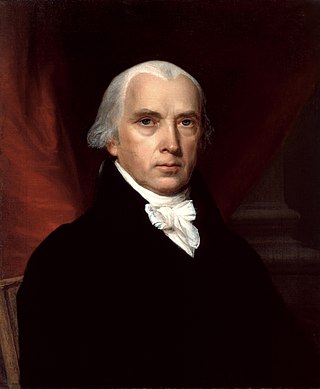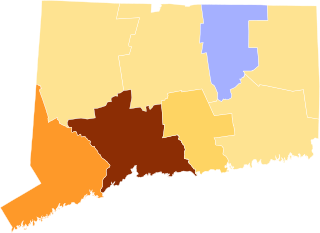The Anti-Masonic Party was the earliest third party in the United States. Formally a single-issue party, it strongly opposed Freemasonry in the United States. It was active from the late 1820s, especially in the Northeast, and later attempted to become a major party by expanding its platform to take positions on other issues. It declined quickly after 1832 as most members joined the new Whig Party; it disappeared after 1838.

Presidential elections were held in the United States from November 2 to December 5, 1792. Incumbent President George Washington was elected to a second term by a unanimous vote in the electoral college, while John Adams was reelected as vice president. Washington was essentially unopposed, but Adams faced a competitive re-election against Governor George Clinton of New York.

Presidential elections were held in the United States from October 30 to December 2, 1812. In the shadow of the War of 1812, incumbent Democratic-Republican President James Madison defeated DeWitt Clinton, the lieutenant governor of New York and mayor of New York City, who drew support from dissident Democratic-Republicans in the North as well as Federalists. It was the first presidential election to be held during a major war involving the United States.

Presidential elections were held in the United States from November 2 to December 5, 1832. Incumbent president Andrew Jackson, candidate of the Democratic Party, defeated Henry Clay, candidate of the National Republican Party.

The 1832 Democratic National Convention was held from May 21 to May 23, 1832, in Baltimore, Maryland. In the first presidential nominating convention ever held by the Democratic Party, incumbent President Andrew Jackson was nominated for a second term, while former Secretary of State Martin Van Buren was nominated for vice president.

The 1832 New York gubernatorial election was held from November 5 to 7, 1832, to elect the Governor and Lieutenant Governor of New York.

The 1832 United States presidential election in Pennsylvania took place between November 2 and December 5, 1832, as part of the 1832 United States presidential election. Voters chose 30 representatives, or electors to the electoral college, who voted for president and vice president.

The 1835 Connecticut gubernatorial election was held on April 6, 1835. It was a rematch of the 1834 Connecticut gubernatorial election. Former governor, senator and Democratic nominee Henry W. Edwards was elected, defeating incumbent governor and Whig nominee Samuel A. Foot with 52.13% of the vote.

The 1834 Connecticut gubernatorial election was held on April 7, 1834. Former senator and Whig nominee Samuel A. Foot was elected, defeating incumbent governor and Democratic nominee Henry W. Edwards with 49.83% of the vote.

The 1833 Connecticut gubernatorial election was held on April 1, 1833. Former senator and Democratic nominee Henry W. Edwards was elected, defeating incumbent governor and National Republican nominee John S. Peters with 41.31% of the vote.

The 1832 Connecticut gubernatorial election was held on April 13, 1832. Incumbent governor and National Republican nominee John S. Peters was re-elected, defeating former senator and Democratic nominee Calvin Willey with 71.44% of the vote.

The 1830 Connecticut gubernatorial election was held on April 8, 1830. Incumbent governor and National Republican nominee Gideon Tomlinson ran essentially unopposed, winning with 96.19% of the vote amidst a scattering of votes.

The 1830 Vermont gubernatorial election took place in September and October, and resulted in the election of Samuel C. Crafts to a one-year term as governor.

The 1831 Vermont gubernatorial election took place in September and October, and resulted in the election of William A. Palmer to a one-year term as governor.

The 1832 Vermont gubernatorial election took place in September and October, and resulted in the election of William A. Palmer to a one-year term as governor.

The 1832 Massachusetts gubernatorial election was held on November 12.

The first 1831 Massachusetts gubernatorial election was held on April 14.

The second 1831 Massachusetts gubernatorial election was held on November 14.

The 1833–34 Massachusetts gubernatorial election consisted of a popular election held on November 11, 1833 and a legislative vote held in January 1834. The task of electing the governor fell to the Massachusetts General Court because no candidate received the constitutionally required majority of the popular vote.

The 1833 Vermont gubernatorial election took place in September and October, and resulted in the reelection of William A. Palmer to a one-year term as governor.





















